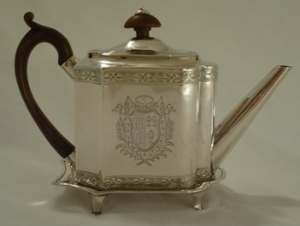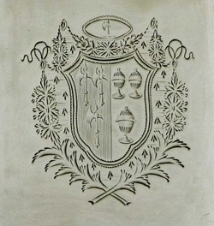by Joanne
and Emmett Eldred
(click on photos to enlarge image)
COLLECTING GEORGE III SILVER TEAPOTS AND STANDS
Why would someone choose to collect George III silver
teapots and stands? Why that period, and why such a narrow
focus? For us the answer is fairly straightforward.
First relates to size. Silver teapots and stands are small so
they are easily portable, and flexible to display. Having at
various times collected 18th century American furniture,
oriental rugs, and contemporary paintings, it became apparent
that space is something that one must consider when collecting.
Even with two houses, there is need for a relatively few pieces
of furniture (e.g., highboys, secretaries, tables, etc), a
limited amount of floor area for rugs, and modest wall space for
hanging paintings. However, silver teapots and stands can easily
be displayed in numerous places, such as on mantels, inside
secretaries, on display shelves, or on top of a variety of
furniture surfaces. Also, being small in size makes storing them
easy – just tuck them inside a tarnish preventing cloth pouch
and pack them away for the season. They are also relatively easy
to ship. Being metal they are not prone to breakage and
typically weigh less than two pounds so UPS or FedEx does not
charge an arm and a leg to ship them internationally. This was
very important since we knew we would likely be purchasing most
pieces remotely and therefore logistic issues could be minimized.
Second relates to authentication. English silver has rigorous
hallmarking standards. Literally altering sterling silver
hallmarks is viewed the same a counterfeiting, since for much of
the 18th century silver was essentially viewed as currency in
England. There are very good reference sources for the various
hallmarks, which makes identifying an English silver piece
pretty straightforward. Also, silver pieces photograph pretty
well and a lot can be determined from a series of detailed
picture (it seems that repairs and damage is accentuated in a
photograph.) This again was important since we would be
purchasing most of our pieces long distance.
Lastly and most importantly, we found this period of English
history to be extremely interesting. Our collecting focus is
from 1780 to 1800, a span of only twenty years, but during this
time England was undergoing major changes artistically, socially,
and economically. But why pick teapots and stands? Tea has
always been a central theme in English life and as such, the
teapot to us seemed to be the perfect choice of an art form
which would accurately reflect the changing tastes and styles of
the period.
Unlike the earlier George II period where teapots bases were
typically of a pedestal design, during this period teapots
typically had flat bottoms, which meant they could potentially
scorch unprotected wood surfaces. This prompted the creation of
teapot stands, or under trays, to protect the surface from heat.
These stands were phased out in early 1800 with the growing use
of serving trays. In our mind, a silver teapot neatly sitting
atop a quaint little stand presents a charming picture of “tea
time” from times past.
George II design was what in America would be characterized as
Queen Anne. Shape was a key factor in George II design --
flowing curves with an emphasis on form, which was reflected in
both overall shape as well as carefully integrated chased
surfaces. Silver teapot designs of this period revolved around a
bulbous, bullet-shape body sitting on a pedestal base. As the
George III period evolved, the style trended toward Regency, or
what in America would be termed Federal, where forms were more
rectilinear in profile and considerable emphasis was given to
engraved rather than chased ornamentation. While engraving and
final forming were still done by hand, machinery was becoming
more prevalent in manufacturing, and many of the wares that
previously were made completely by hand were now being made in
quantity using a combination of machine and handwork. For
example, roller mills were increasingly being used to flatten
silver thus reducing the labor intensive hand hammering required
to flatten a silver ingot into a workable sheet. Also, some
larger shops, such as Hester Bateman’s, were using stamping
machines to cut some of the delicate filigree work or to make a
beaded edging for which her shop ultimately became well known.
Fortunately Federal designs were easily adapted to accommodate
evolving manufacturing technology. It has even been suggested
that the workmen in Hester Bateman’s shop in the 1780s
essentially assembled prefabricated "teapot kits".
During this period the middle class in England was becoming more
affluent and demand increased for affordable luxury items so
they could display their increasing wealth. Fortunately costs
were coming down with the introduction of new production methods
and use of specialized craftsmen, so silver items (including
teapots and stands) could be made more economically for a
rapidly expanding customer base.
However, what most impressed us about this period was the degree
of teapot design innovation. Unlike the earlier George II period
where most teapots were of the Queen Anne bullet shape with
often only the chasing or engraving distinguishing one from
another, teapots made in the 1780s and 1790s ranged in style
from simple oval shapes with minimal engraving to elaborate
serpentine and batwing forms with extensive Federal-themed
engravings. It seemed that craftsmen were able to spend less
time hammering and chasing and more time creating innovative
designs that would potentially entice a customer to purchase one
of their pieces. It is this variety of new and interesting forms
that most attracted us to this period. After 1800, designs
increasing became less rectilinear and, in our eyes, less
appealing.
Like any collectors we had to start somewhere and our start
happened to be on eBay. Our first purchase was a sterling tea
service made by the Currie and Roby firm in New York around
1910. The set was in the George III style and in perfect (apparently
unused) condition. After living with the set for a few months,
we both decided that George III was our preference and made the
plunge again on eBay and purchased our first period George III
teapot and stand. It was made by Henry Chawner in 1792 and was
in wonderful condition with a fantastic engraving of a family
coat-of-arms (actually one family impaling another). As is often
the case with first purchases, our emotion overruled our senses
and we likely paid more than we should have. Nevertheless, it
was the stimulus that got the ball rolling. What followed was an
extensive period of study. We spent untold hours searching out
and recording examples of teapots and stands, which had been
sold or were available (the internet is a great resource in this
respect), as well as researching and learning the various
aspects of heraldry so that family coats-of-arms and/or crests
could potentially be identified.
Quite often initial purchases turn out to be disappointing with
additional learning and experience, however happily the
enthusiasm for our initial Henry Chawner teapot and stand has
not waned.
Henry Chawner 1792
|
Amorial engraving
|
Joanne and Emmett Eldred
- 2011 -
|
|
|


